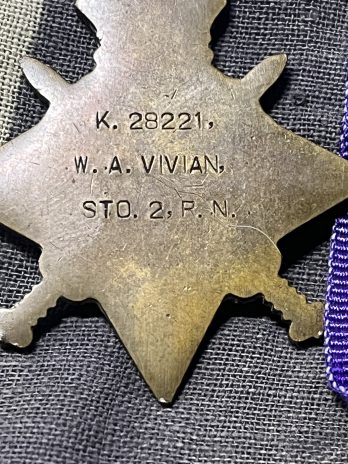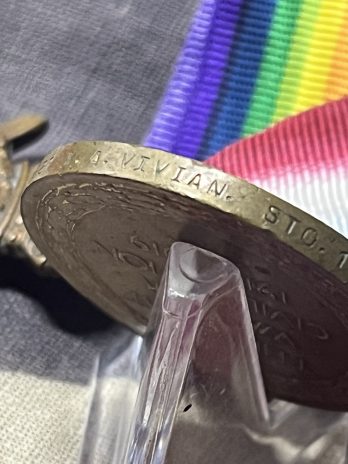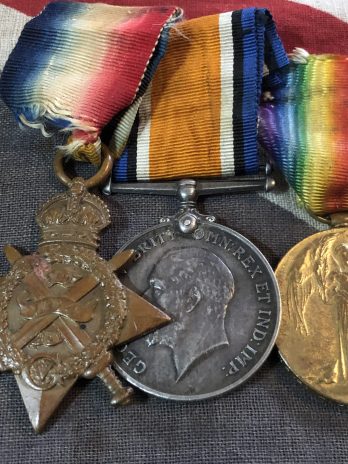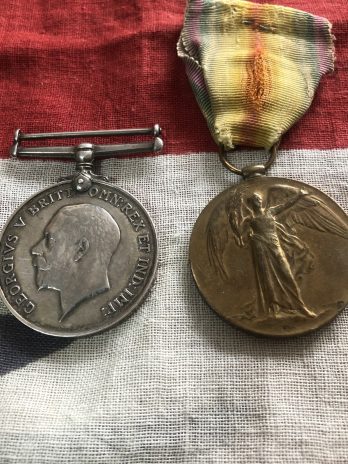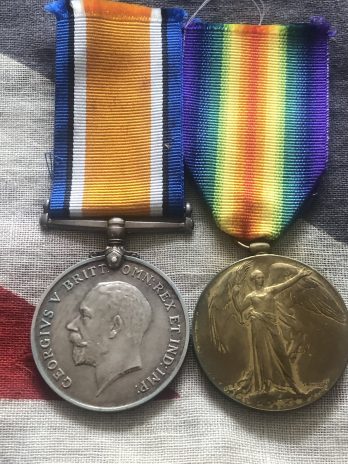Correctly named K28221 WA Vivian Sto2 RN
William Albert Vivian was born in Bath to William and Harriet in 1897.
A fishmonger when he enlisted in late 1915.
He first served with Vivid II before in December 1915 joining HMS Roxburgh. He was with her until April 1919 when he served aboard HMS St Vincent.
HMS Roxburgh and the sinking of SM U89.
In April of 1916 Roxburgh was sent to Norwegian waters and later in September of that year she served on the North America and West Indies Station until the Armistice. On 24 May 1917 she escorted her first American convoy from Hampton Roads, Virginia.
On February 4, 1918 the German U-boat U-89 departed Wilhelmshaven, but unknown to the crew this would be the last time they would see land again. Kapitanleutnant Wilhelm Bauck’s orders were to conduct operations off the St. George’s Channel in the Irish Sea. By February 10 Bauck reports he is just off Peterhead. This would be the last time the German High Command would hear of the U-89.
On February 12, 1918, now painted in dazzle camouflage, the Roxburgh is escorting a convoy just north of Malin Head, which is the most northerly point of the Irish mainland. The Roxburgh, which was then about 24-miles north of Malin Head spots a German U-boat on the surface no more than 200-yards distant, and quickly takes the chase. In the ensuing actions she rams the U-boat and cuts it in two. U-89 commanded by Kapitanleutnant Wilhelm Bauck, sinks with all hands lost, 43 German sailors and the U-89 hits the bottom at position 55.38 North, 07.32 West, where they rest today. For this achievement the Roxburgh wore a merit mark in the form of a star painted on her fore-funnel.
For the crew of the Roxburgh things do not calm down, for there is no rest for a cruiser on escort duty. One day after cutting the U-89 in two the Roxburgh, still on escort duty, comes in contact with another ship. Only this time it is not the enemy but another ship from a different convoy from which the Roxburgh was traveling in. Shortly after mid-night on February 13, 1918 the Roxburgh and the SS Corcovado, (Pacific Steam Navigation Company Ltd) collide with minor damage. At 2:45 on the afternoon of the 14th the Roxburgh was anchored at Tail of the Bank to access the damage. The Tail of the Bank is the name given to the anchorage in the upper Firth of Clyde immediately north of Greenock and Gourock, very near the entrance to the estuary of the River Clyde. The convoy in which the Roxburgh was escorting was later reported to have arrived safely at Belfast.
After he was de-mobbed we find him in 1921 living at 21 Coonwell Lee in Bath and has resumed working as a fishmonger.
William was to marry Elsie Elizabeth Mary Francis in 1919.
In 1939, he has moved to 6 Railway Street in Bath and is now working as a skilled labourer/engineer.
William died in 1958.
Both medals have modern replacement ribbons.
Related products
-
WWI
Victory Medal. William Whittaker. Lancashire Fusiliers. GSW head. Knott Hill, Manchester
£29.50Original price was: £29.50.£27.50Current price is: £27.50. Add to basket






